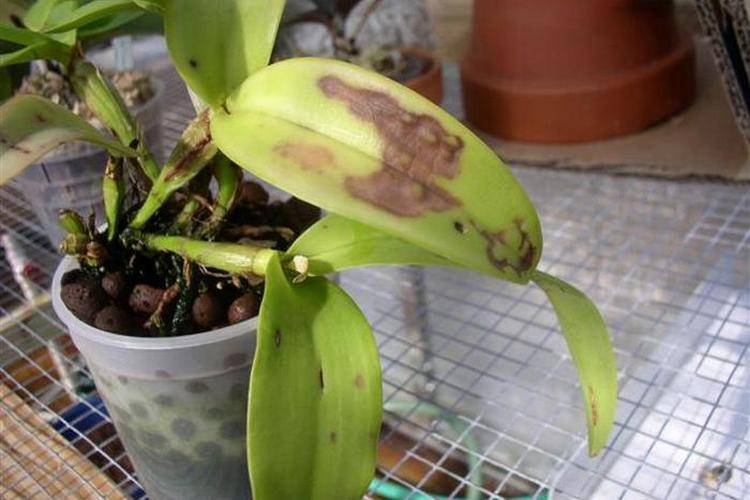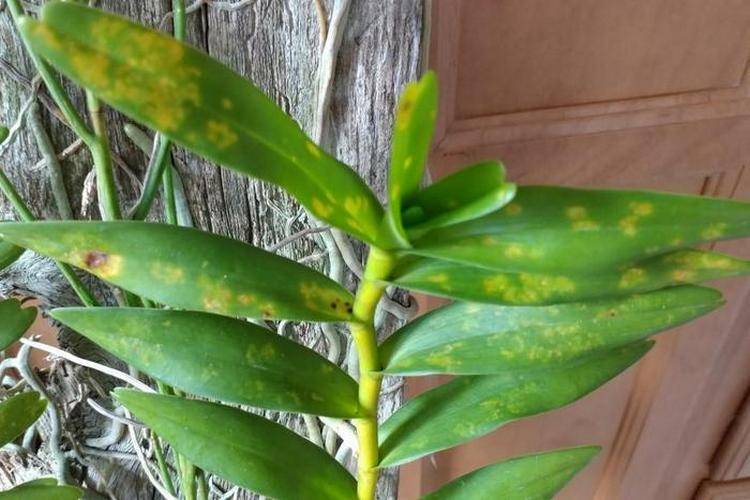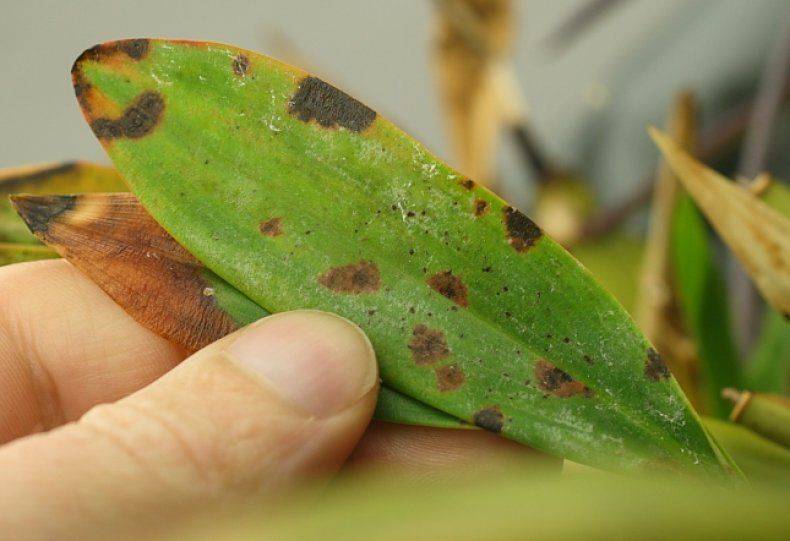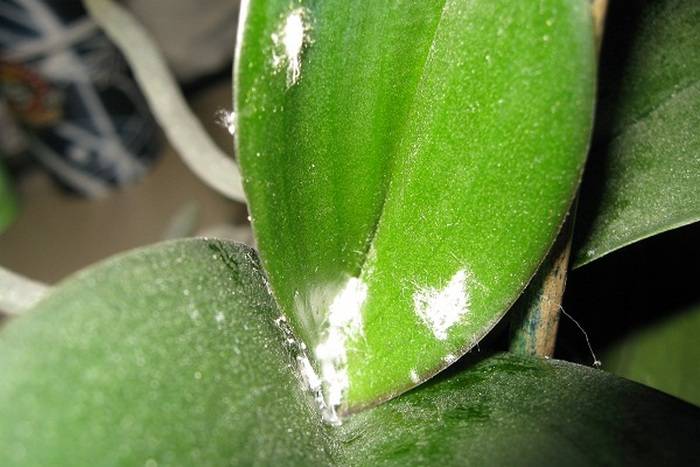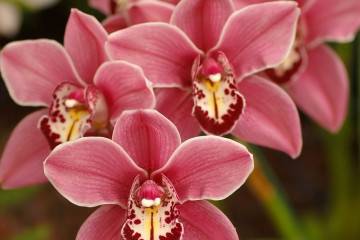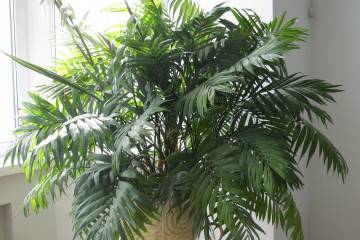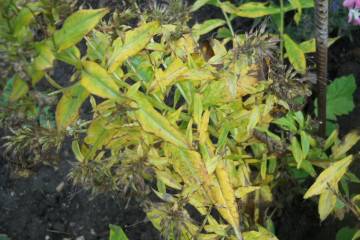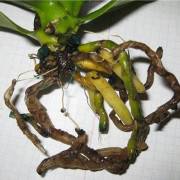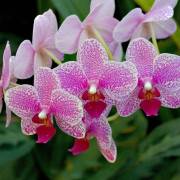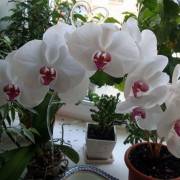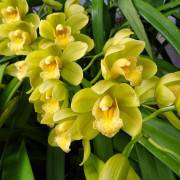Orchid leaves spots - what to do
Content:
Orchid is one of the most beautiful indoor flowers. But it is important to know that this plant is extremely whimsical and requires constant proper care. Among the many diseases that orchids are exposed to, there are those that are easily cured and those that are almost impossible to cope with. In most cases, you can understand what is happening with the flower by its external signs, including the nature of the spots on the leaves.
The main reasons for the appearance of spots on the leaves
There are many reasons for the formation of various marks on orchid leaves. Among them there are those that are associated with violation of plant maintenance rules:
- Sunburn. The problem arises when the orchid is placed in direct sunlight.
- Excessive watering and waterlogging. The appearance of stains is the result of rotting roots.
- Poor drainage. The drainage layer should be at least 1.5 cm in thickness, holes should be made in the bottom of the pot.
- Stagnant indoor air. The room must be regularly ventilated without creating a draft.
- Incorrectly selected pot. Its volume should be 2-3 cm larger than the root system occupies.
- Poor or unsuitable soil. Use only a soil mixture for Orchids, loose and with sufficient bark content.
- Violation of the dosage of fertilization. Overfeeding is dangerous for phalaenopsis, so the instructions for the drugs should be strictly followed.
Quite often, all problems with orchid diseases begin with the described reasons. If care is not promptly adjusted, the consequences will be much more serious.
Types of pigmentation
Externally, the marks that appear on orchid leaves can vary greatly. Their size can vary from a small dot to a large blurred spot. Sometimes even minor spots are present in such an amount that at a distance they look like one large affected area. The color of the spots can also be different: yellow, brown, black, white and more. In shape, lesions can be round, with a smooth edge, convex or concave.
Brown spots
This color of painful markings indicates serious problems. The texture of the stain can be greasy, sticky or dry. The latter arise with high humidity in the room where the flower stands, and over time can destroy the plant.
The damaged parts of the plant must be removed immediately and measures must be taken to heal it while the flower can still be saved.
Black spots
The black dots on the leaves that appear on the orchid indicate the developing late blight, typical for this plant and quite dangerous. Initially, they may have a purple hue, later they become darker, up to complete blackening. Over-watering is usually the cause. Treatment must be started immediately.
Another common disease leading to black spots on the leaves of an orchid is chlorosis. A characteristic distinguishing feature is the twisting of the sheet plate.
White spots
The most common problem with growing orchids is white spots. Such marks let you know about a bacterial, viral or fungal disease that has invaded the plant.
If the lower leaves of the orchid are covered with a white transparent bloom, then most likely the grower encountered powdery mildew. The spots will quickly spread to the roots and shoots of the flower, it will begin to dry and die.
Yellow spots
The appearance of yellow spots indicates a violation of the care of the orchid. Often, due to direct sunlight, yellowish dots appear on the leaves. You can cope with the problem by simply moving the flower to a suitable place or creating shading where it is located. Uneven convex yellow spots, gradually, as it were, pushing the leaf plate - errors in watering, for which you need to use only settled water.
If, on the orchid, spots on the leaves of yellow color are accompanied by black dots, then the plant is affected by a fungal infection.
Evenly colored yellowish markings indicate the presence of bacterial diseases. The reason is too high temperature and insufficient ventilation of the room.
Bright
Strong blotches of saturated colors are not common in orchids. But it also happens that bright red areas become visible on the leaves. This happens for several reasons:
- sunburn;
- brown rot;
- brown rot;
- anthracnose;
- the appearance of a spider mite or scale insect.
You should check all versions and get rid of the identified problem as quickly as possible.
Reasons for the appearance of stains
Having discovered the manifestations of the disease on the leaves of the orchid, it is important to deal with the problem as soon as possible. After it became clear by the nature of the spots what disease or pest had to be faced, one should immediately begin to fight to save the flower.
Bacterial spot
This disease primarily manifests itself on orchid leaves: they first turn yellow, later become dark, sticky, soften and crack. Liquid-filled ulcers appear on the surface of the leaf plates.
Treatment consists in removing the infected parts of the flower and treating the sections with coal dust or iodine solution. If the disease has struck the lobar, then you will have to turn to more effective specialized drugs. In this case, the plant is treated for at least 10 days. Further, for 1.5-2 weeks, the plant is closely monitored so as not to miss a possible relapse of the disease.
Exposure to low temperatures
In the winter season, phalaenopsis orchids need special care, since they are not cold-resistant. It is necessary to provide the plant with warmth (at least 16 ° C) and regular ventilation, exclude spraying. Otherwise, the leaves will be covered with dark spots of fungal origin.
If you bought a phalaenopsis orchid in a store and brought it home in the autumn-winter period, you may encounter another problem. The flower is difficult to adapt in cold weather, its leaves are frostbitten and covered with white spots. It is necessary to cut off the affected areas to healthy tissue and sprinkle the slices with crushed activated carbon.
Orchid viral diseases
It is not uncommon for orchids to be attacked by viral diseases. The infected plant is isolated and destroyed, since the ways to cope with viruses have not yet been developed.
The main reason why the virus infects the orchid is the use of dirty non-sterile instruments when performing grooming procedures. Further, as soon as conditions favorable for the development of the virus arise, it is activated.
At the slightest suspicion of the appearance of a viral disease, the flower is removed away from other plants, treated with a fungicidal preparation and an antibiotic. If there is no improvement, the orchid is destroyed.
Fungal diseases
In most cases, fungal diseases occur in orchids due to a violation of the watering regime, keeping the flower at an unsuitable temperature or excessive moisture level. The diagnosis is confirmed by the fact that spots appeared on the flowers on the orchid. The most common of these diseases are powdery mildew, anthracnose, gray rot. Rust can sometimes occur.
Powdery mildew occurs due to excessively high temperatures or waterlogging of the flower. After detecting signs of the disease, it is recommended to water the flower well and after 2 hours spray it with a solution of colloidal sulfur or Fitosporin. The leaf treatment should be repeated 3-4 times every 10 days.
Violations of watering and temperature conditions can also lead to the appearance of gray rot. The drug Imunnocytofit helps to cope with the disease, which is sprayed on all the ground parts of the plant.
Increased moisture levels and stagnant water can lead to anthracnose. In order to get rid of the disease, problem areas are separated from healthy tissues and the sections are dipped in ash. In the case of volumetric lesions, they resort to using the Mikosan composition.
Rust, which is less common than other fungal diseases, appears due to constant disruption of care, leading to a weakening of the condition of the plant as a whole. In order to combat the disease, the infected parts of the leaves are cut off from the plant, treating the cut sites with crushed coal. It is also allowed to disinfect with a 20% alcohol solution. For large lesions, it is recommended to use the formulations of Mikosan, Skor or Ridomil.
Pests
Among the harmful insects, there are those that most often attack the succulent leaves of the orchid. These include:
- larvae of thrips;
- slugs;
- snails;
- caterpillars;
- nematodes;
- spider mites,
- aphid.
If you do not take timely measures to destroy the pests, they will destroy the plant. As means of fighting insects, the preparations Aktara, Fitoverm, Agravertin proved to be the most effective.
Prevention of spotted diseases
As the main preventive measure in the fight against any types of stains on orchid leaves, care should be taken carefully.
Any problems can be avoided by providing the plant with the following conditions:
- Watering mode. Moisten the soil by immersion and only after it has been dry for at least 2 days.
- Optimum air temperature. The temperature difference during the day should not exceed 4-5 ° C.
- Lighting. Orchids are shown diffused light for 10-12 hours during the day.
- Fertilization. Phalaenopsis is fed twice a month, with a suspension for the duration of the flowering period.
- Correctly selected soil mixture. It should include bark, moss, river sand and peat soil.
It is also worth remembering the need to create a good drainage layer that provides air access to the roots.
In the event of ailments that appear on the leaves, it is important to correctly identify the source of the problem and eliminate it.Follow-up care is structured so as not to repeat the mistakes made. Compliance with the described recommendations will be the key to the health and beauty of a home orchid.

